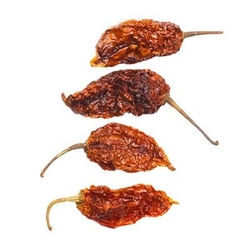You Might be a Chile Head...

Do you think you have what it takes to consider yourself a chilehead? Ask yourself these questions:
Do you put lots of Tabasco sauce on your breakfast eggs?
Have you ever eaten a whole raw chile just because?
Do you prefer habanero (or maybe even ghost chile) flakes on your pizza over the tame red pepper flakes?
Do you know what the Trinidad Moruga Scorpion and Smokin' Ed's "Carolina Reaper" are?
If you answered yes to more than one of these questions...well, you might be a chile head.
Who Are Chile Heads?
Chile heads, also known as chileheads, chili heads, pepper heads and thanks to Aaron and Roger "Heat Seekers". They are a growing segment of the population (although not yet officially recognized by the US Census) and this group is well known by food manufactures of all shapes and sizes. A true chile head doesn't just enjoy the warmth and heat of chile peppers, fiery hot salsas and lava like hot sauces, they literally crave them, it's how they're hard-wired. The resulting endorphin chile rush is just as powerful as what runners call "runners high" and why chocoholics describe their love of chocolate as a walk on a thin line that borders between addiction and obsession.
You would be mistaken to think that a chile head only cares about the heat. While they may crave heat they understand that a really good chile is also loaded with flavor. A chile head has to develop a sophisticated palate just as a wine connoisseur has to develop theirs. Besides fine-tuning their taste buds to pick up complex flavor nuances, a chile head tends to naturally build up their heat tolerance at the same time. Chile heads consider all things chile to be serious stuff. Naturally there is a leading magazine publication - Chile Pepper Magazine. A major university dedicated to chiles - The Chile Pepper Institute is located at New Mexico University and has been researching chile peppers since the late 1800's. And if you're a true chile head, you have to make at least one pilgrimage to the Mecca of the chile pepper and visit Hatch, New Mexico, which bills itself the chile pepper capital of the world. Each Labor Day weekend they host the Hatch Chile Festival which will attract more than 30,000 visitors.
Some chile heads might be more particular to dried chiles, including flakes and powders, while others prefer to make their own chile pastes. Still others like to grow them fresh and some lean toward the wide variety of hot sauces available. It doesn't really matter how you like your chile heat or which flavor profile you prefer, a true chile head is always searching for the next opportunity to enjoy the sometimes simple and sometimes complex flavor nuances of their favorite type of chiles (and the delightful beads of sweat that only these heavenly little capsicums can provide).
Where Do Chiles Get Their Heat?
What drives this chile mania? Science, naturally. Capsaicin pronounced "cap SAY sin" is the active component in chile peppers, which are the fruits of plants belonging to the genus Capsicum. Capsaicin is found in large amounts in these fruits or chile pods. While the fleshy part of the pod holds some heat, it is really the inner wall's white pith, or internal membranes, that holds the greatest concentration of capsaicin. Contrary to popular belief, the seeds do not produce the real heat and actually tend to be slightly bitter.
So how do chile heads gauge heat? To understand the heat you have to become very familiar with the SHU rating of the individual chiles. SHU stands for Scoville Heat Units. The Scoville scale measures the spicy heat of the chile pepper and the greater the Scoville heat units (SHU) the greater the presence of capsaicin. To get a better appreciation consider that a sweet red bell pepper has a SHU rating of 0. No heat at all. The wildly popular jalapeno has an SHU rating of 3,000 to 8,000. One of the workhorses of Mexican cuisine is the Ancho chile which tips the scales at a rather pedestrian 1,000 to1,500 SHU. Now as you graduate up to the Habanero you start to experience some serious heat as these come in at 150,000 to 325,000 SHU.
For many years a variation of the habanero (the Red Savina) was considered the world's hottest chile pepper at 500,000-580,000 SHU. Several years ago it was unseated by an Indian Chile called Bhut Jolokia, which is also called the "Ghost Chile". It rates 800,000 to 1,041,000 SHU. In early 2012 this short lived champion was knocked off by the Trinidad Moruga Scorpion, which registers as high as 2,009,000 SHU. Today, the hottest chile in the world is Smokin' Ed's 'Carolina Reaper'. This chile could probably make you breathe fire, seeing that the SHU ranking reached above 2,200,000 at its peak heat.
Why does a chile show such a wide variation in SHU heat ranges? Think of two pieces of fruit that grows on the same tree. They can each have a slightly different shape, color and size. Now compare one tree to another tree on the other side of the orchard where even the soil can be a bit different. Even more differences can exist from one end of the growing region to the other. So by giving a range, you can cover multiple harvest areas and still be within the acceptable heat range for that particular chile.
If your mouth was watering while reading this, maybe it's time to go buy some chiles, or maybe you were even eating a chile at the time...
...Congrats! You're a chile head.


